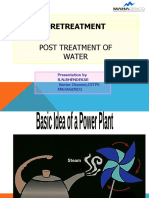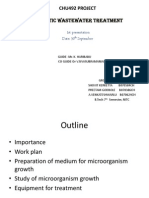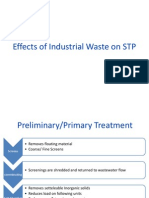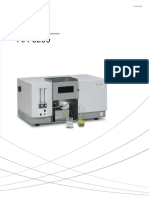Design of Upflow Anaerobic Sludge Blanket Uasb Reactor For Jam Industry Wastes IJERTV2IS90665 PDF
Design of Upflow Anaerobic Sludge Blanket Uasb Reactor For Jam Industry Wastes IJERTV2IS90665 PDF
Uploaded by
Amir HusinCopyright:
Available Formats
Design of Upflow Anaerobic Sludge Blanket Uasb Reactor For Jam Industry Wastes IJERTV2IS90665 PDF
Design of Upflow Anaerobic Sludge Blanket Uasb Reactor For Jam Industry Wastes IJERTV2IS90665 PDF
Uploaded by
Amir HusinOriginal Title
Copyright
Available Formats
Share this document
Did you find this document useful?
Is this content inappropriate?
Copyright:
Available Formats
Design of Upflow Anaerobic Sludge Blanket Uasb Reactor For Jam Industry Wastes IJERTV2IS90665 PDF
Design of Upflow Anaerobic Sludge Blanket Uasb Reactor For Jam Industry Wastes IJERTV2IS90665 PDF
Uploaded by
Amir HusinCopyright:
Available Formats
International Journal of Engineering Research & Technology (IJERT)
ISSN: 2278-0181
Vol. 2 Issue 9, September - 2013
Design of Upflow Anaerobic Sludge Blanket (UASB) reactor for Jam Industry
Wastes
1 2
M.M.C.Rajivgandhi and M.Singaravelu
1
Research scholar, 2Professor, Department of Bioenergy,
Agricultural Engineering College and Research Institute,
Tamil Nadu Agricultural University, Coimbatore- 641 003.
Abstract stabilized effluent which is almost neutral in pH and
is odourless (Bardiya et al., 1996). Fruit-processing
Upflow Anaerobic Sludge Blanket (UASB) reactors wastes are highly biodegradable as they are rich in
have been widely used for the treatment of industrial organic matter and have a high (above 50% ) moisture
wastewater. An Upflow Anaerobic Sludge Blanket content. It has been established that bio-conversion
Reactor was designed to handle 8,800 liters per day of processes are more suitable than thermo-conversion
the influent and field tested for energy production from processes. So, there exists a vast scope for the energy
biomethanation of papaya fruit processing jam industry recovery as well as waste management, through
RT
wastes. The reactor has the total height of 5.4 m and establishment of proper design of biomethanation plants
diameter of 1.6 m. Effective volume and total volume of for the fruit industries.
the reactor are 8.84 m3 and 10.8 m3 respectively. The
IJE
optimum organic loading rate (OLR) observed to be 2.67 2. Materials and methods
kg of COD. m-3 day-1, when the reactor was operated at
three days HRT. The COD removal efficiency is 70 % The UASB was designed to treat the fruit waste water
and the specific gas production is 0.577 m3 kg-1 of COD anaerobically for biogas generation. The temperature
removed per day. range (which affects solid retention time), and the flow
fluctuations (which affect the upflow velocity) are also
Keywords: Biomethanation, Fruit wastes, UASB considered. The design features of the UASB reactor
reactor, UASB design design are presented below in Table 1.
Table 1.Important design features of UASB reactor
1. Introduction
Upflow Anaerobic Sludge Blanket (UASB) reactor in S. Parameters Assumptions Ref.
the late 1970s in the Netherlands by Lettinga. UASB No
process is used most commonly, with over 1500 1. Solid retention time 40 days [6]
installations treating wide range of industrial waste 2. Temperature of reactor 20º - 32º C [4]
waters. 3. BOD removal yield 0.1 g VSS /g [2]
Papaya and pineapple are the fruits which are widely coefficient BODremoved
being processed for manufacturing the finished products 4. Degradable residues of 90% [6]
such as jam, jelly, etc. Utilization of these commodities VSS coming in the
results in 30 to 35 % of waste generation (Rajivgandhi et inflow
al., 2013). These wastes are either uneconomically 5. COD removal efficiency 80 % [6]
utilized or disposed of as such, thereby causing 6. Reactor height 4 – 5.9 m [2]
serious pollution problems.In recent years, attention is 7. Average concentration 75 % [2]
being given to treating the fruit wastes and waste water of sludge in blanket
chemically or biologically to obtain useful by-products 8. Effective depth of 2.2 m [2]
before the final disposal. Of the many alternatives, sludge blanket
biomethanation of fruit wastes is the best suited 9. Theoretical CH4, m3 / kg 0.35 m3 [2]
treatment, as the process not only adds energy in the COD removed
form of methane, but also results in a highly
IJERTV2IS90665 www.ijert.org 1674
International Journal of Engineering Research & Technology (IJERT)
ISSN: 2278-0181
Vol. 2 Issue 9, September - 2013
Analysis analyzed. The pH of the fruit wastewater is observed to
vary from 4.02 to 5.9.
Parameters like pH, total solids (TS), volatile solids The total solid content of the fruit wastewater is
(VS), total suspended solids (TSS), volatile suspended found to vary between 1375 and 1625 mg L-1 and the
solids (VSS) and Chemical Oxygen Demand (COD) volatile solid content varies between 1130 and 1326 mg
were analyzed as per the APHA (1998) methods. L-1. The BOD of the fruit wastewater is found to vary
between 1250 and 1610 mg L-1 and the COD varies
3. Results and discussion between 3000 and 3800 mg L-1. The BOD: COD ratio
was determined and it is found to vary between 0.41 and
The physico-chemical characteristics of the fruit 0.42. The Total Kjeldahl Nitrogen (TKN) is observed to
wastewater and mixtures of solid and liquid wastes were vary from 2.4 to 3.4 mg L-1. The value of TOC varies
from 1290 to 1310 mg L-1. The C: N ratio of the waste
water is found to vary from 35.2 to 36.4.
3.1 Design of the reactor
The physico – chemical characteristics of the sludge bed play a key role in deciding the biomethanation capacity of
the reactor. The amount of daily deposition of sludge depends on the characteristics of raw waste water. The design of
the reactor is accomplished as described below,
3.1.1 Total Sludge Production
i) New VSS produced as a result of BOD removal, the yield coefficient assumed as 0.1 g VSS/g BOD removed.
RT
Influent BOD, (mg/L) BOD
New VSS produced in BOD Removal, (mg/L) Removal (%) Yield cofficient ,
IJE
(g VSS/g BOD removed)
,ii) The non-biodegradable residue of the VSS coming in the inflow is given by
Non-degradable residue, (mg/L) = VSS,(mg/L) ×(1- degradable fraction)
iii) Ash received in the inflow can be calculated as
New Ash received in the inflow, (mg/L) = TSS, (mg/L) – VSS, (mg/L)
The sum of the above three components gives total sludge produced per day
New VSS produced in BOD removal, (mg/L)
Total sludge produced,(kg/day) Non - degradable residue, (mg/L)
Ash received in the inflow, (mg/L)
3.1.2 Solid Retention Time
The solid retention time of a system also depends on the characteristics of the wastewater
Total quantity of sludge present in the reactor, (kg)
Solid retention time, (days)
Quantity of sludge removed per day, (kg/day)
IJERTV2IS90665 www.ijert.org 1675
International Journal of Engineering Research & Technology (IJERT)
ISSN: 2278-0181
Vol. 2 Issue 9, September - 2013
Average Concentration of sludge in the blanket, (kg/m 3 )
x Effective depth of the sludge blanket, (m)
x Effectiven ess coefficien t , (%)
SRT, (days)
x Hydraulic Retention time, (h)
Total quantity of sludge produced, (mg / L)
3.1.3 Hydraulic retention time (HRT)
Solid retention time Total quantity of sludge produced 24
Hydraulic retention time
Average concentration of sludge in the blanket
Effective depth of the sludge blanket
Effectiven ess coefficien t
3.1.4 Upflow velocity
RT
Reactor Height, (m)
Upflow Velocity, (m/h)
Hydraulic Retention, Time (h)
IJE
The liquid upflow velocity in the reactor is directly related to reactor height. In a conventional UASB system,
the average daily value of liquid upflow velocity for domestic wastewater should not exceed 0.7 m/h (Lettinga and
hulshoff Pol, 1991).
3.1.5 Area of Reactor
A cylindrical reactor was considered and the area of the reactor can determined as follows:
3
2 Flow rate, (m /h)
Cross sectional area of reactor, (m )
Upflow velocity, (m/h)
3.1.6 Diameter of the reactor
2 2
Reactor area, (m ) d
4
The designed reactor has the total height of 5.4 m and retention time’s viz. 1 day, 3 days and 5 days. The
diameter of 1.6 m. Effective volume and total volume optimum organic loading rate (OLR) observed to be
of the reactor are 8.84 m3 and 10.8 m3, respectively. 2.67 kg of COD. m-3 day-1, when the reactor was
Schematic diagram of UASB reactor shown in Fig.1. operated at three days HRT. The COD removal
efficiency is 70 % and the specific gas production is
The influent with COD load of 5000, 8000 and 0.577 m3 kg-1 of COD removed per day.
11000 mg L-1 were tested for each of the hydraulic
IJERTV2IS90665 www.ijert.org 1676
International Journal of Engineering Research & Technology (IJERT)
ISSN: 2278-0181
Vol. 2 Issue 9, September - 2013
5. References
[1] APHA, 1998. Standard Methods for the
Examination of Water and Wastewater,
20th Ed. American Public Health Association,
Washington DC.
[2] Arceivala, S. J. (2000). Wastewater Treatment
and Pollution Control, 2nd Ed., Tata McGraw Hill,
New Delhi, India.
[3] Bardiya, N., Somayaji, D. and Khanna, S. 1996.
Biomethanation of banana peel and
pineapple waste. Bioresour. Technol., 58:73–76.
[4] Lettinga, G., S.W. Hobma, A. Klapwijk, A.F.M.
VanVelsen and W.J.D. Zeeuw. 1980. Use of the
Fig 1. Schematic diagram of UASB reactor Upflow Sludge Blanket (USB) Reactor Concept for
Biological Wastewater Treatment. Biotechnol.
3.2 Cost Economics Bioeng., 22: 699 - 734.
[5] Lettinga, G. and Hulshoff Pol, L.W. 1991.
The cost economics is the most important UASB Process Design for Various Type
consideration of any proposed engineering system. of wastewater. Water Sci. Technol., 24 (8): 87 -
The total cost of the plant (fabrication cost of the 107.
reactor, installation of the reactor, slurry pump,
RT
[6] Mahmoud, N., Zeeman, G. Gijzen, H. and
pipelines and other accessories) is Rs.80,000. Daily Lettinga. G. 2003. Solids Removal in Upflow
gas production is 10 m3 day-1, which amounts to a Anaerobic Reactors, A Review. Bioresour,
value of Rs. 52,920/ year. The reactor produces Technol., 90: 1 – 9.
IJE
2010 kg of sludge in a year, which gives an income [7] Rajivgandhi, M.M.C., Singaravelu, M. and
of Rs. 24,120/ year. From the estimation it is seen Kamaraj, S. 2013. Study on Bio-methanation of
that the reactor has the payback period of 3 to 4 Papaya Fruit Processing Industrial Wastes. Madras
years. Agric. J., 100 (Special Issue): 212-215, May 2013.
4. Conclusions
The results obtained on biomethanation of
papaya fruit processing wastes reveal that the
anaerobic treatment of papaya fruit wastes is
technically feasible. The energy generated in the
form of methane, when utilized efficiently, not only
improves the overall economy of these fruit
processing industries, but also provides onsite
solutions to waste management problems.
IJERTV2IS90665 www.ijert.org 1677
You might also like
- 0 0 25 Feb 2016 1108554031AnnexureManufacturing&EffluentTreatmentProcessDocument28 pages0 0 25 Feb 2016 1108554031AnnexureManufacturing&EffluentTreatmentProcessNeerav Indrajit GadhviNo ratings yet
- Uv 80/2 LCD - LCD Plus: Manual of Installation, Use and ServicingDocument19 pagesUv 80/2 LCD - LCD Plus: Manual of Installation, Use and ServicingVladimirs Arzeninovs100% (1)
- Jet AerationDocument6 pagesJet AerationIzhary Siregar100% (1)
- Mathematical Modeling of Upflow Anaerobic Sludge Blanket (UASB)Document8 pagesMathematical Modeling of Upflow Anaerobic Sludge Blanket (UASB)Fernando RamírezNo ratings yet
- Presentation1 (Latest)Document24 pagesPresentation1 (Latest)mirdza94No ratings yet
- PELLE AND CARTA TECNOLOGI KHED 10 KLD STP - MBBR - ManualDocument79 pagesPELLE AND CARTA TECNOLOGI KHED 10 KLD STP - MBBR - ManualPravinsingh SarakNo ratings yet
- IWA Publishing - Anaerobic Reactors For Sewage Treatment Design, Construction and Operation - 2020-01-10Document1 pageIWA Publishing - Anaerobic Reactors For Sewage Treatment Design, Construction and Operation - 2020-01-10Tho Hoang0% (1)
- R.O. Plants (11.10.23)Document17 pagesR.O. Plants (11.10.23)Afsal JhNo ratings yet
- Flygt Progressive CacvityDocument8 pagesFlygt Progressive CacvityAhmed WagihNo ratings yet
- Water Purifier Home in DubaiDocument33 pagesWater Purifier Home in DubaiaquaproNo ratings yet
- Indion 8211Document2 pagesIndion 8211Vinayak UppinNo ratings yet
- MB Caln at 45 Deg C For 10 MinDocument4 pagesMB Caln at 45 Deg C For 10 MinwertyyyNo ratings yet
- Bio STP Offer 15 KLDDocument7 pagesBio STP Offer 15 KLDगरुड़ प्रकाश पांडेNo ratings yet
- Comparison of Price For Water Treatment Chemicals by The Following 3 VendorDocument1 pageComparison of Price For Water Treatment Chemicals by The Following 3 VendorAK TRIPATHINo ratings yet
- Global Care Enviro System Tamil Nadu IndiaDocument10 pagesGlobal Care Enviro System Tamil Nadu IndiaGlobal Care Enviro SystemNo ratings yet
- Raw WaterDocument41 pagesRaw WaterEzhil Vendhan PalanisamyNo ratings yet
- Water Treatment of Evaporative CondensersDocument14 pagesWater Treatment of Evaporative CondensersFred SibugNo ratings yet
- CSTPS ChemistryDocument146 pagesCSTPS ChemistryRitesh MokhadeNo ratings yet
- Mini Project ReportDocument5 pagesMini Project ReportSaj BhaiNo ratings yet
- Reed Bed System FINALDocument12 pagesReed Bed System FINALHardik Kashyap VepariNo ratings yet
- Bwa NSFDocument2 pagesBwa NSFdalton20030% (1)
- Sajid HussainDocument48 pagesSajid HussainTimothy GarciaNo ratings yet
- Log SheetDocument30 pagesLog Sheetandy rahman liputoNo ratings yet
- Charter of ECRADocument13 pagesCharter of ECRAMahmood MuftiNo ratings yet
- Potassium Permanganate As Oxidant in The Cod Test For Saline Water SamplesDocument11 pagesPotassium Permanganate As Oxidant in The Cod Test For Saline Water SampleskomodobutaNo ratings yet
- Removal of Boron From Waste Waters by Ion Exchange in A Batch SystemDocument4 pagesRemoval of Boron From Waste Waters by Ion Exchange in A Batch Systemx_mentunhienNo ratings yet
- Project Report For Residential STPDocument107 pagesProject Report For Residential STPKhiara Claudine EspinosaNo ratings yet
- KDI-538Document1 pageKDI-538KELVIN TECHNOLOGIESNo ratings yet
- Esco Waste InceneratorDocument4 pagesEsco Waste InceneratorRizki Try AtmantiNo ratings yet
- Presentasi Waste Water Treatment PlantDocument8 pagesPresentasi Waste Water Treatment Plantika yuliyani murtiharjonoNo ratings yet
- Domestic Waste Water Treatment PPDocument9 pagesDomestic Waste Water Treatment PPPreetam Godbole100% (1)
- Xyz Industries LTD.: Operation & Maintenance ManualDocument49 pagesXyz Industries LTD.: Operation & Maintenance ManualamolbagadeNo ratings yet
- Project Profile On Battery Water PDFDocument2 pagesProject Profile On Battery Water PDFSuresh KaushikNo ratings yet
- 1st Presentation On Chemistry of Water TreatmentDocument7 pages1st Presentation On Chemistry of Water TreatmentAnonymous RsTfwYVcNo ratings yet
- NTPC TDSDocument40 pagesNTPC TDSKELVIN TECHNOLOGIESNo ratings yet
- Perhitungan Kebutuhan ChemicalDocument49 pagesPerhitungan Kebutuhan ChemicalDavid LambertNo ratings yet
- WTP - Opeation Engineer - GulfDocument2 pagesWTP - Opeation Engineer - GulfmaniyarasanNo ratings yet
- Organic Waste ConverterDocument6 pagesOrganic Waste ConverternandeeshNo ratings yet
- Planning Report Kasur 2008Document41 pagesPlanning Report Kasur 2008zobeeNo ratings yet
- Effects of Industrial Waste On STPDocument11 pagesEffects of Industrial Waste On STPManu JainNo ratings yet
- Silica Removal and Silica LeakageDocument2 pagesSilica Removal and Silica LeakageSandeep MishraNo ratings yet
- Mobile Reverse Osmosis Units: For Purified Water NeedsDocument4 pagesMobile Reverse Osmosis Units: For Purified Water NeedsVeera SekarNo ratings yet
- Press Mud - StudyDocument6 pagesPress Mud - StudySRINIVASAN TNo ratings yet
- 250 LPH Ro PlantDocument4 pages250 LPH Ro PlantKamatchi NathanNo ratings yet
- E Series RO 2000 LPH - Final NRP 27092021Document10 pagesE Series RO 2000 LPH - Final NRP 27092021Anand_HvacNo ratings yet
- Removal of Chromium From Tannery Solid WasteDocument7 pagesRemoval of Chromium From Tannery Solid WasteLuis Paz Soldán G100% (1)
- Memstar Membrane - 2022 - Final Version - CompressedDocument38 pagesMemstar Membrane - 2022 - Final Version - CompressedBudi IswahyudiNo ratings yet
- Amercor 8760 BM ENGDocument12 pagesAmercor 8760 BM ENGchoppersureNo ratings yet
- Proposal - Suheung Vina 30.05.2023 (Rev) To Kim LeeDocument17 pagesProposal - Suheung Vina 30.05.2023 (Rev) To Kim LeedaniNo ratings yet
- Ozone PaDocument8 pagesOzone PaAmbar AmKaNo ratings yet
- Flat Sheet MBR MembraneDocument18 pagesFlat Sheet MBR MembraneNIHAR SHAHNo ratings yet
- SOP Ozone GeneratorDocument6 pagesSOP Ozone Generatorاحمد عبدالكريم الحماديNo ratings yet
- Chemicals For Flocculation and Dewatering Treatment: Kuriflock Pa-322Document1 pageChemicals For Flocculation and Dewatering Treatment: Kuriflock Pa-322ROCKN'UNLMTD StudioNo ratings yet
- Atomic Absorption Spectrophotometer: Printed in Japan 3655-01408-20AITDocument12 pagesAtomic Absorption Spectrophotometer: Printed in Japan 3655-01408-20AITAnonymous xCSrahNo ratings yet
- Commissioning Strategy For The Anaerobic Sludge Digesters PDFDocument8 pagesCommissioning Strategy For The Anaerobic Sludge Digesters PDFOktay Duygu AcaroğluNo ratings yet
- Shortcut Nitrogen Removal-Nitrite Shunt and DeammonificationFrom EverandShortcut Nitrogen Removal-Nitrite Shunt and DeammonificationNo ratings yet
- Hydrogen Production TechnologiesFrom EverandHydrogen Production TechnologiesMehmet SankirNo ratings yet
- Optimization of Anaerobic Mechanism Using Response Surface Methodology (RSM) To Treat Pulp and Paper Industry Wastewater: A ReviewDocument9 pagesOptimization of Anaerobic Mechanism Using Response Surface Methodology (RSM) To Treat Pulp and Paper Industry Wastewater: A ReviewEditor IJTSRDNo ratings yet
- A Study On Scale Up Process in Phycoremediation of Rice Mill Effluent by Scenedesmus AbundansDocument12 pagesA Study On Scale Up Process in Phycoremediation of Rice Mill Effluent by Scenedesmus AbundansEnvirevo AgritechNo ratings yet
- Sewer DesignDocument19 pagesSewer Designaakalim88% (16)
- The Purification of Wastewater On A Small Scale byDocument6 pagesThe Purification of Wastewater On A Small Scale byAray ArayNo ratings yet
- 20m3pd STP-MBR-2Document1 page20m3pd STP-MBR-2BENJAMIN UNALANNo ratings yet
- An Experimental Investigation On Treatment of Sewage WaterDocument15 pagesAn Experimental Investigation On Treatment of Sewage Waterteam siikeNo ratings yet
- Eval Ipal Industri Penyamakan KulitDocument13 pagesEval Ipal Industri Penyamakan KulitAhmad AfzalNo ratings yet
- Isea Super Plus - Activated Sludge Plant - Treatment of Domestic Waste WatersDocument3 pagesIsea Super Plus - Activated Sludge Plant - Treatment of Domestic Waste WatersAG-Metal /Tretman Otpadnih Voda/Wastewater Treatment100% (1)
- Water and Wastewater Treatment: CEGE0022Document22 pagesWater and Wastewater Treatment: CEGE0022abdul5721No ratings yet
- Unit-7. Watewater Treatment MethodDocument108 pagesUnit-7. Watewater Treatment MethodIshwar singh DhamiNo ratings yet
- STP (200kld) - Technical Datasheet 17.02.23Document150 pagesSTP (200kld) - Technical Datasheet 17.02.23Rajender Chamoli100% (1)
- Effluent Requirement PDFDocument2 pagesEffluent Requirement PDFCM SoongNo ratings yet
- TurbidityDocument2 pagesTurbiditySapna JoshiNo ratings yet
- Calculation SheetDocument17 pagesCalculation SheetMohamed Arafat100% (3)
- 2024 Module 4 - Microbes in Sewage TreatmentDocument4 pages2024 Module 4 - Microbes in Sewage TreatmentKhadeeja RushinNo ratings yet
- Additional Problems For The Streeter-Phelps EquationDocument2 pagesAdditional Problems For The Streeter-Phelps EquationDEXTERNo ratings yet
- Lesson 12 - Overview of The Wastewater Treatment ProcessDocument6 pagesLesson 12 - Overview of The Wastewater Treatment ProcessZar ChiNo ratings yet
- MBR Membrane Provider (Megavision)Document34 pagesMBR Membrane Provider (Megavision)nk100% (1)
- Water Treatment PlantDocument8 pagesWater Treatment PlantjiwojaNo ratings yet
- Wwe Question BankDocument45 pagesWwe Question Banknehamya100% (3)
- Chapter 1 Fundamentals 2023Document11 pagesChapter 1 Fundamentals 2023Quân VõNo ratings yet
- BioKube Patent Treatment Process With Smell EliminationDocument33 pagesBioKube Patent Treatment Process With Smell EliminationJuan Jose SanguezaNo ratings yet
- Dasherkandi Sewerage Treatment Plant Is Located in The Capital City DhakaDocument2 pagesDasherkandi Sewerage Treatment Plant Is Located in The Capital City DhakaMohammad FarhanNo ratings yet
- Apes - Chapter 21 Water PollutionDocument66 pagesApes - Chapter 21 Water PollutionZaman RaiNo ratings yet
- Extended Aeration Wastewater Treatment SystemDocument12 pagesExtended Aeration Wastewater Treatment Systemashe zinab100% (2)
- Standard DWA-A 118E: German DWA Rules and StandardsDocument37 pagesStandard DWA-A 118E: German DWA Rules and StandardsZoran Kostić100% (4)
- Lake Braddock Post-LabDocument3 pagesLake Braddock Post-Labapi-3830933No ratings yet
- Design 2 MLDDocument9 pagesDesign 2 MLDANIL KUMAR H CNo ratings yet
- Laboratory 6 - FiltrationDocument14 pagesLaboratory 6 - Filtrationcherrytanierla07No ratings yet
- Waste Water Treatment Seminar ReportDocument24 pagesWaste Water Treatment Seminar ReportMayur DeshmukhNo ratings yet
- Date PH Turbidity Conductivity - NTU S/CMDocument29 pagesDate PH Turbidity Conductivity - NTU S/CMmainul qulubiNo ratings yet
- Certificate of Analysis ListDocument3 pagesCertificate of Analysis ListJorge Luis ParraNo ratings yet

























































































